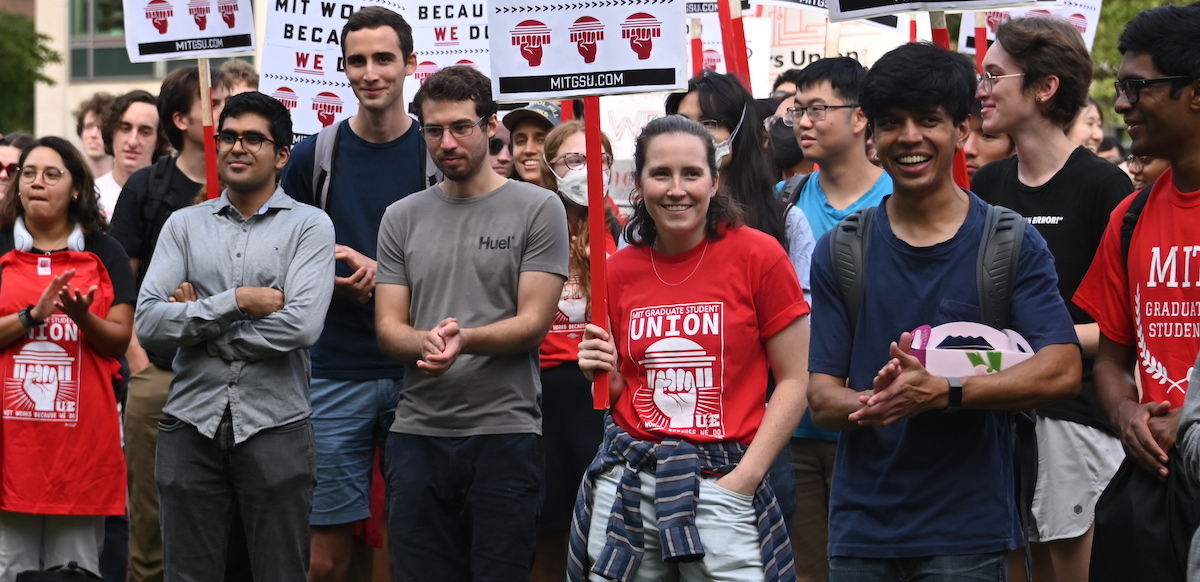How Tens of Thousands of Grad Workers Are Organizing Themselves

After a groundbreaking win at MIT, graduate workers elsewhere borrowed talking points for organizing research assistants in science, technology, engineering, and mathematics.
It’s the biggest organizing wave the U.S. labor movement has seen in decades. Graduate workers are unionizing in huge numbers, winning drive after drive with 90 percent support or more.
What’s more, the workers are in the driver’s seat of these campaigns, with little help from union staff.
Most union organizing these days relies on a staff-heavy approach that’s tough to scale up. But the grad worker upsurge offers a sketch of a worker-led model that could help reverse labor’s decline.
The United Electrical Workers (UE) alone has organized close to 30,000 graduate workers over the past year and a half. We’ve won elections at eight major universities, including MIT and the University of Minnesota. Workers at other universities have voted to unionize with UNITE HERE, the United Auto Workers, and other unions.
At some campuses, grad workers have signed up 1,000 co-workers into the union in a single day and reached majorities on “vote yes” petitions within weeks.
Such massive mobilizations wouldn’t be possible if they relied mainly on union staff. We couldn’t move this fast if union staff had to talk with every worker, or even if a staffer had to train and debrief every worker doing outreach to others.
Instead, we’re training workers up on organizing methods, tapping into their knowledge of their own workplaces and co-workers… and then letting the organizing snowball, as workers train others who train others, and the campaign takes on a life of its own.
This isn’t how UE or other unions typically organize. But the grad upsurge demanded a new way of doing things. We had to release the reins to catch up to how fast the workers were going.
The relationship between union staff and rank-and-file workers has changed. Staff became educators and facilitators, guiding workers through the challenges of new organizing. Workers now develop their leadership skills by training other organizing committees, growing a national movement.
The roots of this strategy reach deep into our union’s past, when UE leaders first built their union in electrical and machine shops without the help of outside staff. In other words, this capacity isn’t unique to graduate workers. We believe this worker-led model can be tried in other workplaces too.
HANDED LEADERS THE REINS
The graduate workers have built large organizing committees of hundreds on each campus, where workers taught each other organizing skills and helped each other develop into leaders.

SUPPORT LABOR NOTES
BECOME A MONTHLY DONOR
Give $10 a month or more and get our "Fight the Boss, Build the Union" T-shirt.
Our goal: Turn every supporter into a leader, and every leader into a trainer.
Organizing tasks that might traditionally be reserved for union staff were transferred to the worker-leaders. For instance, workers built and maintained the organizing databases, in which department organizers registered their notes and assessments.
Data was broadly shared, rather than remaining the domain of a closed group of staff, so that hundreds of worker organizers could use it to track their conversations and develop their department strategies.
We scaled up our organizing with walkthroughs, where workers went in pairs to approach their colleagues in labs and offices around campus—a chance to reach into new departments, build their confidence as organizers, and fine-tune the organizing script all at once.
Rather than hand out the union’s answers to frequently asked questions, workers brainstormed the best answers together. This left them much better prepared when new anti-union talking points cropped up in their departments. Using their crowdsourced FAQ, workers trained themselves to undermine captive-audience anti-union meetings and turn them against their supervisors.
NETWORKS ACROSS CAMPUSES
Strategies and materials that worked well were passed from campus to campus.
Many graduate worker drives had failed in the science, technology, engineering, and mathematics departments. So after the groundbreaking win at MIT—one of the largest STEM universities in the country—organizers at other campuses borrowed their talking points on why research assistants need a union.
Graduate workers at Northwestern, University of Chicago, and Johns Hopkins were organizing simultaneously, so they ran joint trainings and exchanged materials.
The grad workers at Stanford, Dartmouth, and Cornell had the benefit of lessons learned from all these prior campaigns. At Stanford they got more than 2,000 union cards signed in a single day.
On each campus, workers adapted and expanded the methods, always evaluating what might not work here—and trusting that they knew their own workplace better than anyone else.
Valentina Luketa is the UE National Coordinator for Higher Education.





